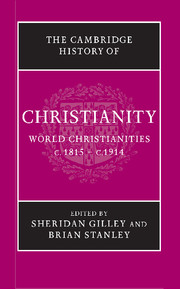Book contents
- Frontmatter
- 1 Introduction
- PART I CHRISTIANITY AND MODERNITY
- 2 The papacy
- 3 Theology and the revolt against the Enlightenment
- 4 The growth of voluntary religion
- 5 Catholic revivalism in worship and devotion
- 6 Women preachers and the new Orders
- 7 Church architecture and religious art
- 8 Musical trends and the western church: a collision of the ‘ancient’ and ‘modern’
- 9 Christianity and literature in English
- 10 Christian social thought
- 11 Christianity and the sciences
- 12 History and the Bible
- 13 Popular religion and irreligion in countryside and town
- PART II THE CHURCHES AND NATIONAL IDENTITIES
- PART III THE EXPANSION OF CHRISTIANITY
- Select General Bibliography
- Chapter Bibliography
- Index
- References
13 - Popular religion and irreligion in countryside and town
from PART I - CHRISTIANITY AND MODERNITY
Published online by Cambridge University Press: 28 March 2008
- Frontmatter
- 1 Introduction
- PART I CHRISTIANITY AND MODERNITY
- 2 The papacy
- 3 Theology and the revolt against the Enlightenment
- 4 The growth of voluntary religion
- 5 Catholic revivalism in worship and devotion
- 6 Women preachers and the new Orders
- 7 Church architecture and religious art
- 8 Musical trends and the western church: a collision of the ‘ancient’ and ‘modern’
- 9 Christianity and literature in English
- 10 Christian social thought
- 11 Christianity and the sciences
- 12 History and the Bible
- 13 Popular religion and irreligion in countryside and town
- PART II THE CHURCHES AND NATIONAL IDENTITIES
- PART III THE EXPANSION OF CHRISTIANITY
- Select General Bibliography
- Chapter Bibliography
- Index
- References
Summary
Christianity spread in the Roman empire as an urban religion, and the term ‘pagan’ originally meant a country-dweller. In the second millennium of the church’s history in Europe popular Christian practice became the norm in the countryside, and such difficulties as there were tended to be found in the towns. The nineteenth century proved to be a much more testing time for the church than before, and the urban population grew very rapidly. In 1800 only the Netherlands had more than a quarter of its population living in towns of more than 10,000 inhabitants. By1890 Great Britain had a predominantly urban population, and the proportion in towns of over 10,000 exceeded 30 per cent in Belgium, Prussia and Saxony as well as the Netherlands. The main reason for this change was industrialisation, though not all new industry developed in towns.
Population growth posed significant problems for the church, particularly when associated with urbanisation, because of the need for new churches and more clergy. Not with standing significant efforts made by the church – sometimes with active assistance from government, sometimes by raising funds from benefactors – levels of religious practice were not sustained. It became possible to argue, as one contemporary, Karl Marx, did, that industrialisation exposed the essential flaws in religion. Against this background sociologists developed a cluster of theories of secularisation to describe or explain the changes in the modern period; the extent to which they have explanatory force has remained controversial.
- Type
- Chapter
- Information
- The Cambridge History of Christianity , pp. 197 - 214Publisher: Cambridge University PressPrint publication year: 2005
References
- 1
- Cited by

